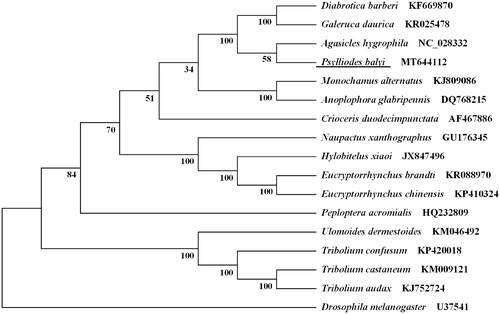Abstract
The complete mitogenome of Psylliodes balyi Jacoby (GenBank accession number MT644112) is 14,561 bp in length, and contains 13 protein-coding genes (PCGs), 22 transfer RNA genes (tRNAs), 2 ribosomal RNA genes, and a putative control region. The gene content and orientation of P. balyi were identical to other beetle mitogenomes. ATT, ATA, and ATG were initiation codons and TAA, TAG, and T were termination codons. All the 22 tRNAs have the typical cloverleaf secondary structure, except for trnS1 which lacked the dihydrouracil (DHU) arm. The phylogenetic relationship based on the neighbor-joining method showed that P. balyi is closely related to Agasicles hygrophila, which agrees with the conventional classification.
Keywords:
The eggplant flea beetle, Psylliodes balyi Jacoby (Coleoptera: Chrysomelidae), is a major pest of eggplants and distributed widely in Southern China. The adults of P. balyi feed on the leaves and the larvae bore into the roots of eggplants, causing great economic losses in eggplant cultivated areas (Yang et al. Citation2010). In this study, adult species of P. balyi were collected from the vegetable field in Guizhou province of China (N26°33′, E106°46′). The samples were preserved in 95% ethanol and stored in the insect specimen room of Henan Academy of Agricultural Sciences with an accession number HAAS-Col-20190901.
The complete mitochondrial genome of P. balyi (GenBank accession number MT644112) is a circular DNA molecule of 14,561 bp in length, and contains 13 protein-coding genes (PCGs), 22 transfer RNA genes (tRNAs), two ribosomal RNA genes (rrnL and rrnS), and a putative control region. The gene content and orientation of P. balyi were identical to other beetle mitogenomes (Li et al. Citation2016; Zhou et al. Citation2016). Twenty-three genes were encoded on the minor strand (J-strand), while the others were transcribed on the major strand (N-strand). The overall base composition was as follows: A (34.16%), T (42.15%), C (11.59%), and G (12.10%), with an A + T bias (76.31%). The AT-skew and GC-skew of this genome were −0.105 and 0.021, respectively. Gene overlaps were found at 17 gene junctions and involved a total of 55 bp, and the longest overlap (8 bp) existed between trnY and cox1. There were four intergenic spacer regions ranging in length from 2 to 17 bp, comprising a total length of 36 bp. The largest intergenic spacer sequence of 17 bp was located between trnS2 and nad1. The 22 tRNAs had a total of 1446 bp, and their individual lengths ranged from 63 bp (trnE and trnF) to 72 bp (trnW). Consistent with most animal mitogenomes (Wolstenholme Citation1992; Yuan et al. Citation2016), all the 22 tRNAs have the typical cloverleaf secondary structure, except for trnS1 which lacked the dihydrouracil (DHU) arm. The rrnL and rrnS were 1280 and 742 bp in length, with the A + T contents of 81.88% and 81.67%, respectively. The control region was located between rrnS and trnI with a length of 17 bp, and the A + T content was 88.24%.
All the 13 PCGs start with typical ATN codons, including two ATAs (nad3 and nad4L), five ATGs (atp6, cob, cox2, cox3, and nad4), and six ATTs (atp8, cox1, nad1, nad2, nad5, and nad6). Nine PCGs terminate with conventional stop codons (TAA or TAG), and the remaining PCGs including cox1, cox2, cox3, and nad5 use single T as a stop codon. According to the relative synonymous codon usage analyses of 13 PCGs, TTA (L), TTT (F), ATT (I), and ATA (M) were the four most frequently used codons. Leucine, isoleucine, phenylalanine, and methionine are the most frequent amino acid of 13 PCGs. Based on the concatenated amino acid sequences of 13 PCGs, the neighbor-joining method was used to construct the phylogenetic relationship of P. balyi with 15 other beetles. The result showed that P. balyi was closely related to Agasicles hygrophila (), which agrees with the conventional classification.
Disclosure statement
No potential conflict of interest was reported by the author(s).
Data availability statement
The data that support the findings of this study are openly available in GenBank at https://www.ncbi.nlm.nih.gov/genbank/, reference number MT644112.
Additional information
Funding
References
- Li N, Wei JN, Jia D, Li S, Ma RY. 2016. The complete mitochondrial genome of the flea beetle Agasicles hygrophila. Mitochondrial DNA A DNA Mapp Seq Anal. 27(5):3670–3671.
- Wolstenholme DR. 1992. Animal mitochondrial DNA: structure and evolution. Int Rev Cytol. 141:173–216.
- Yang LW, Ding LW, Yang JW, Chen JZ, Dai YT, Gan CL. 2010. Occurrence and control of flea of eggplant in summer. J Changjiang Veg. 13:41.
- Yuan ML, Zhang QL, Zhang L, Guo ZL, Liu YJ, Shen YY, Shao RF. 2016. High-level phylogeny of the Coleoptera inferred with mitochondrial genome sequences. Mol Phylogenet Evol. 104:99–111.
- Zhou XR, Han HB, Pang BP, Zhang PF. 2016. The complete mitochondrial genome of Galeruca daurica (Joannis) (Coleoptera: Chrysomelidae). Mitochondrial DNA A DNA Mapp Seq Anal. 27(4):2891–2892.

